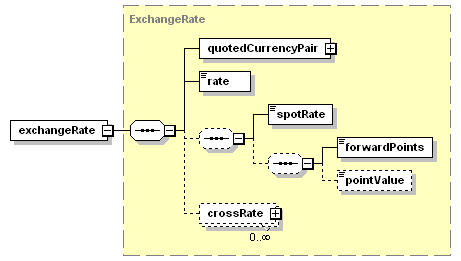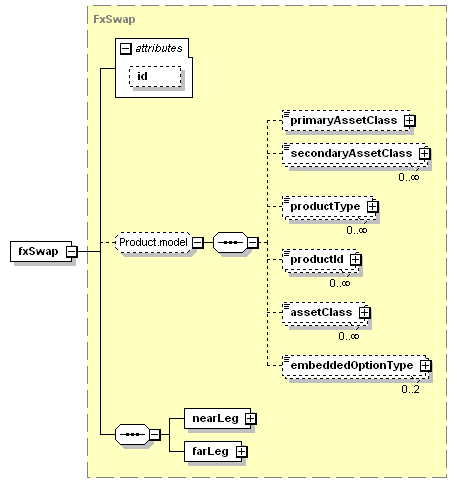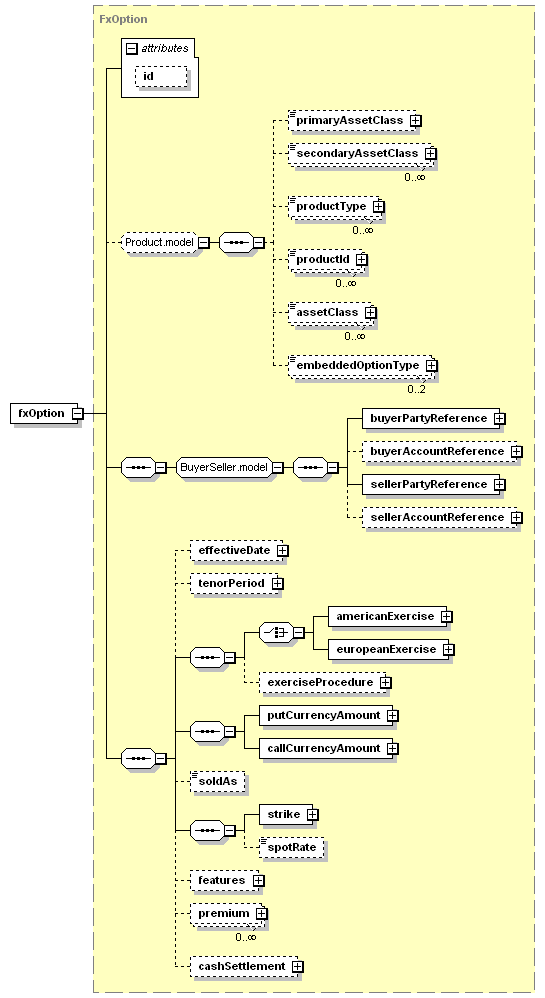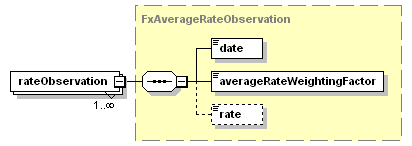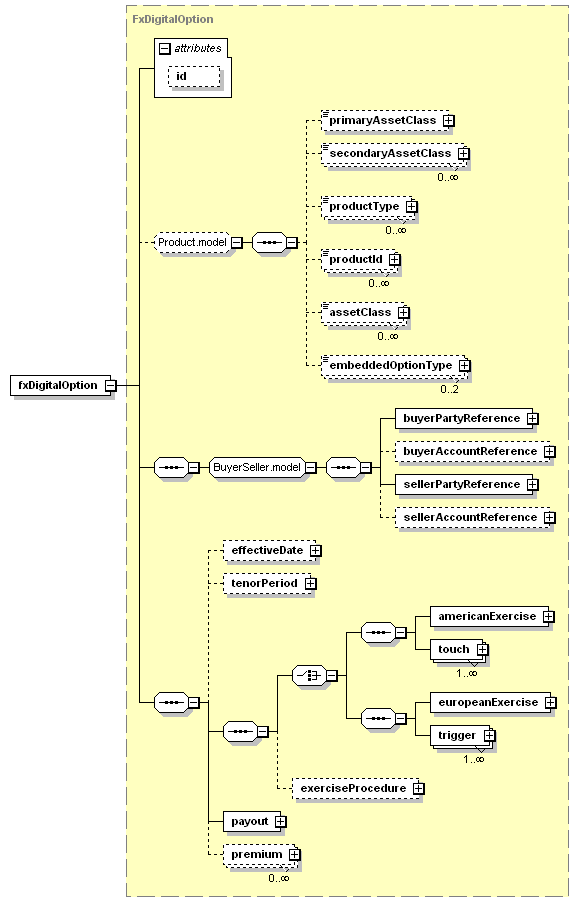8.1 FX Scope
The Scope of FpML 5.3 Recommendation includes redesigned FX product model developed by the Modeling Task Force (MTF) and FX Working Group to make it more consistent with other FpML product representations and to facilitate its further development. As a result of this work many of an original 4.x model’s issues were addressed:
- A number of sets of reusable components that facilitates product development were defined, so that the existing and future FX products will leverage these building blocks to ensure the FX model is coherent and easy to maintain, as per FpML best practices
- Extended the existing coverage to include Dual Currency Deposits.
- Rationalized the models' constraints:
- Made use of grammar to bring related data together.
- Made better use of XML schema to simplify the validation rules.
In FpML 5.3 Recommendation the following FX products are covered:
- Basic FX Products
- FX Spot and FX Forward (including non-deliverable settlements, or NDFs)
- FX Swap
- Simple FX Option Products (including, features, cash and physical settlement)
- FX options
- European and American
- Averaging
- Barriers
- Digital Options
- FX options
- Option Strategies (multiple simple options)
In addition, support for the following money market instrument is also provided:
- Term Deposits (including features)
- Money Market Deposits
- Dual Currency
Foreign exchange single-legged instruments include spot and forwards. fxSingleLeg contains a reusable entity (FxCoreDetails.Model) that describes common components to FX spot, forward and swap legs: two instances of the exchangedCurrency component (the first currency and the second currency), an optional dealtCurrency that indicates which currency was dealt, either a single value date component for the trade or an optional value date per exchanged currency, an optional tenorPeriod that (appears in the Reporting View only) denotes the tenor on which both currencies traded will settle, a single instance of the exchangeRate component, and an optional nonDeliverableSettlement component. Note: An optional confirmationSenderPartyReference (to the party that is sending the current document as a confirmation of the trade is accommodated) has been moved out from the product economics. It will be placed at the trade level.
|
|
The simple FX transaction contains two currencies which are exchanged between parties. The characteristics of each currency exchange: the currency, the amount, and optionally settlement instructions are described in the exchangedCurrency structure. An optional payment date is allowed per currency if there is a requirement to provide for date adjustments for each currency based upon business day conventions to accommodate unscheduled holidays.
|
|
8.2.1.1 Settlement Information
An optional settlementInformation structure has been included for each exchanged currency. This can be used in a variety of ways: not at all, flagging a trade for standard settlement, flagging a trade for settlement netting, or specifying the detailed settlement instructions for that particular currency flow.
|
|
8.2.1.1.1 Settlement Instruction
|
If the specific settlement instruction is included, then this is broken out into correspondent, intermediary, and beneficiary information. This includes the identification of the routing mechanism (e.g., SWIFT, Fedwire, etc.) that the trade will settle via and the id and account that the trade will settle via. Routing can be handled either via purely a routing id (e.g., SWIFT code), routing details (a customer name, address, and account number), or a combination of routing id and details. The following diagrams show the correspondent, intermediary, and beneficiary structures. |
8.2.1.1.1.5 Split Settlement
Split settlement is also accommodated. Split settlement will mean that there will be multiple beneficiaries associated with a single trade, where the payment amounts are broken down between beneficiaries. The following diagram shows how this has been modeled:
|
|
The rate of exchange is required for a foreign exchange trade. The rate of exchange includes a reusable entity (QuotedCurrencyPair) that describes the underlying composition of the rate: the currencies and the method in which the rate is quoted. The actual trade rate is required, but other rate information such as spot rate, forward points and point value are also accommodated. For non-base currency trades, cross rates (or rates to base) to accommodate the currency exchange rates to cross between the traded currencies are provided for. Note: the refactored rate of exchange model has stricter grammar than FpML 4.x, which eliminates a few rules (e.g. fx-1, fx-2, fx-3, fx-28, fx-29 ).
|
|
Non-deliverable settlement is catered for within the conventional FX single leg structure by including an optional non-deliverable information structure that is used to describe a particular type of FX forward transaction that is settled in a single currency (for example, a non-deliverable forward). This content identifies the agreed-upon settlement currency and describes the fixing date and time, as well as the settlement rate source that the fixing will be based upon. The non-deliverable structure is shown below.
|
|
|
|
|
|
A foreign exchange swap is a single product that combines two trades, either spot/forward or forward/forward. (The FpML 4.x model allowed any number of exchanges but the new restricts it to just two. In the old model FX Swap was a container for other products – like a strategy. In the new model it's a single product). A standard FX swap contains only two legs, nearLeg and farLeg to indicate the value date order. There are a variety of different types of FX swaps in the marketplace: standard (round-amount) swaps, overnight swaps, unequal-sided swaps, forward-forward swaps. All of the features that are available within FxCoreDetails.Model, common components to standard FX spot and forward trades (described previously) can be utilized in describing an FX swap as well.
|
|
Near and far legs are based on a new FxSwapLeg type and derived from a super type Leg from which all swap legs are extended (and is not derived from Product as in 4.x).
|
|
Foreign exchange options model is completely redesigned compared to 4.x model that was very loose with too many independent optional elements. It did not enforce relationships between elements. The basic data types used for values like rates had no constraints (e.g. could be negative). The model is designed to bring related data together and many elements were renamed in line with FpML naming convention and MTF recommendations.
Foreign exchange options are now more consistent with other option products. FxOption type extends new Option base type - a type that defining the common features of options - buyer and seller model and derived from a Product type (the Option type could be used to re-factor other option types). It also includes separate exercise structures for standard European and American options.
FxOption structure now can be used for both "vanilla”, as well as for Averaging and Barriers options that are represented in fxOption as ‘features’ and not as separate products like in 4.x.
A vanilla fxOption identifies an exercise style, the put currency and amount, and call currency and amount, strike price and premium information. The premium is structured similar to an exchanged currency for a conventional FX trade, where optional settlement information for the premium can be attached. In addition, there are optional procedures associated with the exercise, a soldAs reference to allow buyer/seller perspective to be easier to derive – did I buy a put or sell a call, spotRate that this represents the current market rate for a particular currency pair. Note: quotedAs component has been removed as it was a legacy element carried through the versions and the group felt it was confusing.
|
|
8.4.1.1 American Exercise
Fx American Exercise structure includes additional support for multipleExercise with optional limits on the notional size.
|
|
|
|
8.4.2.1 Fx Barrier Feature
The 4.x FX barrier option model extended fx option product with spot rate, fx barrier and trigger payout. As part of the refactoring work, Asian and/or Barrier represented as a new features to the FxOption and not as separate products. An fxOption with barrier features - a conventional option except that it is changed in a predetermined way when the underlying trades at predetermined barrier levels. Foreign exchange barrier features defines the level and the condition for activation. A knock-in option pays nothing at expiry unless at some point in its life the underlying reaches a pre-set barrier and brings the option to life as a standard call or put. A knock-out option is a conventional option until the price of the underlying reaches a pre-set barrier price, in which case it is extinguished and ceases to exist. Barrier options have both a strike price and a barrier price.
An FxBarrierTypeEnum is used to allow for differentiation between knockin, knockout, reverse knockin, and reverse knockout options. One or more barriers are supported. The reference spot rate, while optional, is recommended, as it determines whether the option need to go up or down (or is "out-of-the-money" or "in-the-money") in order to hit the barrier. Below are the structures for an FX OTC barrier features.
|
|
8.4.2.2 Fx Asian Feature
Foreign exchange asian features - (sometimes referred to as asian or average rate) captures the parameters for the average rate calculation. FxOption with asian feature is an option whose payout is based upon the average of the price of the underlying, typically (but not necessarily) over the life of the option. These options are popular because they are usually cheaper than conventional options because the averaging process over time reduces volatility.
FxAsianFeature includes a FX rateObservation component, a collection of specific observation dates, accompanied by a specific weighting factor and average rate options on occasion when struck already have agreed-upon rate observations in the past. FX rateObservation can be produced either as an independent representation of a series of specific observation dates, or to supplement the parametric representation of the observationSchedule (e.g., daily, 2nd Friday, etc.), utilizing the same rolling convention schemes as utilized within the interest rate derivatives area. The model is constructed as an “at-least-one-of” model which enforces the existence of observationSchedule, or rateObservation, or both. Below are the structures for an FX OTC asian feature.
|
|
|
|
|
|
|
|
The rateObservation collection is optionally accompanied by a rateObservationQuoteBasis, allowing this to be made explicit.
The following diagram shows a graphical view of a collection of specific observation dates, accompanied by a specific weighting factor and average rate options:

|
|
Where the observation schedule is represented parametrically, the rateObservation series may be absent, or limited to observations which have already occurred – but now the observed rate values are accompanied by their weighting factor:
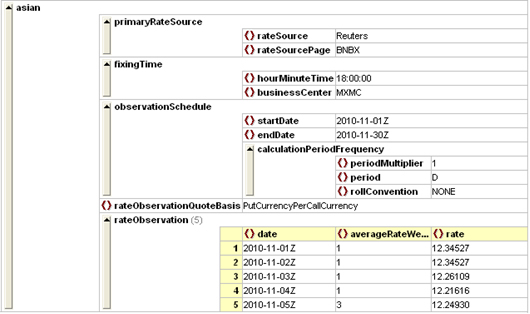
|
|
A combination of an average rate and one or more barrier are supported.
The cash Settlement component specifies the currency and fixing details for cash settlement. It has the identical underlying type that is also used within FX Single leg and FX Swap products (see section 8.2.3.). This cash Settlement optional structure is produced only where it has been specified at execution time that the option wlll be settled into a single cash payment - for example, in the case of a non-deliverable option (although note, that an Fx option may be contractually cash settled, without necessarily being non-deliverable). Physical delivery means - entering into a spot transaction for currency delivered on both sides. Cash settlement means - settling into one of the option currency or quanto arrangement, and then supply FX spot rate observation and other parameters in the cash settlement block.
|
|
|
|
|
|
The terms binary and digital are not clearly defined in the FX markets and can occasionally be synonymous. This is used to define an option that has a discontinuous payout profile. It typically pays out a fixed amount if the underlying satisfies a predetermined trigger condition or else pays nothing. Unlike the standard option, the amounts quoted are the payout amounts as opposed to a notional underlying amount. Below are the structures for FX OTC binary and digital options.
|
|
Fx digital option model uses grammar to ensure triggers match the exercise style.
Digital options typically are defined as being European, meaning the observation occurs only if the spot rate trades above (or below) the trigger level on expiry date. The two examples that have been included in the specification are the digital and the range digital.
|
|
|
|
Binary options, on the other hand, are more like American options, meaning that the payout occurs if the spot rate trades through the trigger level at any time up to and including the expiry date. The four examples that have been included in the specification are the one-touch, no-touch, double one-touch, and double no-touch binary options.
|
|
|
|
The term deposit is an agreement between two parties to enter into a financial contract. Similar to a forward rate agreement, a term deposit is contained within a single component and contains no interim interest payments. It is an on-balance sheet transaction that pays interest at maturity based upon an agreed interest rate. While the term deposit instrument is technically an interest rate product, it is included within the FX section of FpML because many institutions that utilize FX transactions also conduct short-term deposits in their respective portfolios to fund foreign currency requirements.
Although there are a number of structured deposits that are occasionally transacted in the marketplace, including deposits with amortizing structure, rate set schedules, and periodic interest payment or interest recapitalization schedules, or even deposits that are denominated in one currency but pay interest in another currency, those types of transactions represent a significant minority of the number of deposits dealt in the wholesale financial marketplace. Therefore, the term deposit structure is intentionally very simple to accommodate the simple yet highly liquid deposit instruments.
The fixed interest rate + the foreign exchange option that can provide a higher rate of return become increasingly popular. These products are confirmed as a single trade which combines deposit and option data attributes. In FpML 5.1, a dual currency option has been modeled as a ‘feature’ that is embedded into a term deposit that causes the payout to be in a second currency.
|
Note that both the start date and maturity date of the term deposit is negotiated upfront and are typically of short duration, so the dates of these instruments are fixed. Any unforeseen holidays will generally cause for renegotiation of the contract. Therefore there are no allowances for date adjustments. |
|
|
The variants of main Term Deposit product are represented in the redesigned model as term deposit features (e.g. Dual Currency feature). There are other variants that could be added (e.g. deposit taker can decided interest and principal payment currency).
Dual Currency Term Deposits is a term deposit with an embedded option that causes the payout to be in a second currency. The fixed interest rate + the foreign exchange option can provide a higher rate of return. These products are confirmed as a single trade which combines deposit and option data attributes which has been modeled as a ' features' that can be added to a term deposit. Element ‘ dualCurrency' of type 'DualCurrencyFeature' represents Dual Currency Deposit using the 'termDeposit' product's 'features', instead of the 'strategy' like in 4.x model ( [termDeposit] and [fxSimpleOption] products).
|
|
One or more financial instruments, of any sort that are supported by the FpML specification, can be combined to form what is called a strategy. This can include various packages of the same or different asset classes in a single trade. Typical examples of this would include option packages (e.g., straddles, strangles) or a delta hedge (FX OTC option with spot risk hedged by FX spot deal). Additionally, other asset classes can be combined in a strategy (e.g., interest rate swap with FX, etc.).









